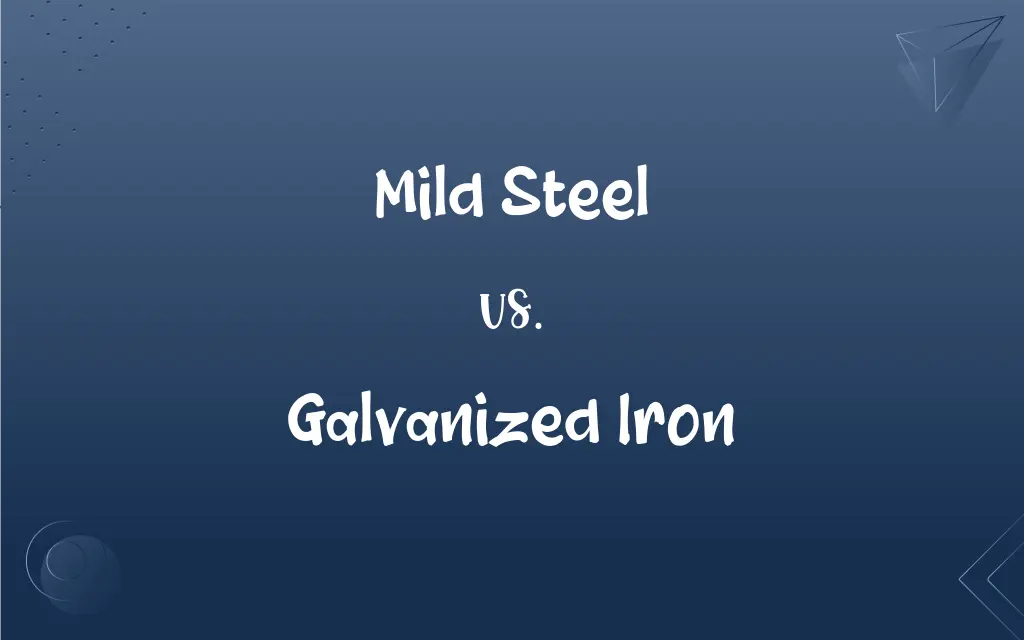Mild Steel vs. Galvanized Iron: What's the Difference?
Edited by Aimie Carlson || By Harlon Moss || Published on December 10, 2023
Mild steel is a low-carbon steel known for its malleability and ductility, whereas galvanized iron is iron coated with a protective layer of zinc to prevent rusting.

Key Differences
Mild steel, an alloy of iron and carbon, contains a small percentage of carbon, making it more ductile and malleable than other steel types. It is commonly used in construction and manufacturing due to its strength and weldability. Galvanized iron, on the other hand, is iron that has been coated with a layer of zinc. This zinc coating provides corrosion resistance, which extends the life of products made from iron or steel, especially in outdoor or moist environments.
The primary characteristic of mild steel is its low carbon content, which results in less hardness but more flexibility compared to high carbon steels. It is widely used for creating everyday steel products like automobile chassis, cookware, and furniture. Galvanized iron, by contrast, is characterized by its protective zinc coating. The galvanization process, typically through hot-dip or electroplating, makes it ideal for applications where rust resistance is crucial, such as in roofing, guttering, and fencing.
Mild steel is susceptible to corrosion when exposed to the elements, which limits its use in certain environments without additional protective coatings. However, it is preferred for its ease of fabrication and versatility. Galvanized iron, due to its zinc coating, is much more resistant to rust and corrosion, making it suitable for outdoor use and in industries like construction and automotive where longevity and durability are key.
In terms of appearance, mild steel generally has a duller, more matte finish, while galvanized iron has a distinctive bright, shiny surface due to the zinc coating. This difference in appearance also plays a role in their selection for aesthetic purposes.
Both mild steel and galvanized iron are used extensively in various industries, they differ significantly in terms of composition, corrosion resistance, applications, and appearance. Mild steel is known for its flexibility and ease of use, whereas galvanized iron is chosen for its durability and resistance to corrosion.
ADVERTISEMENT
Comparison Chart
Composition
Low carbon steel.
Iron coated with zinc.
Corrosion Resistance
Prone to rust without coatings.
Highly resistant to rust due to zinc coating.
Applications
Common in construction, automobile manufacturing.
Used in outdoor or moist environments, like roofing.
Appearance
Duller, matte finish.
Bright, shiny surface due to zinc.
Properties
Ductile and malleable.
Harder and more durable.
ADVERTISEMENT
Mild Steel and Galvanized Iron Definitions
Mild Steel
Commonly used steel in everyday products.
Mild steel is used in the manufacturing of home appliances.
Galvanized Iron
Durable and suitable for moist environments.
Galvanized iron gutters are effective in preventing rust.
Mild Steel
A type of carbon steel with low carbon content.
Mild steel beams are used in building construction for their strength.
Galvanized Iron
Iron coated with a layer of zinc for rust protection.
Galvanized iron sheets are used for roofing due to their durability.
Mild Steel
Steel widely used for its weldability.
The gate was constructed from welded sections of mild steel.
Galvanized Iron
Preferred in construction for its corrosion resistance.
Galvanized iron is used in making metal fences around pools.
Mild Steel
Iron alloy known for its malleability.
Mild steel is preferred for making custom car parts due to its flexibility.
Galvanized Iron
Commonly used for outdoor metal products.
The park benches are made of galvanized iron to withstand weather.
Mild Steel
Less hard but more flexible than high carbon steels.
Mild steel pipes are easier to bend and shape.
Galvanized Iron
Characterized by a shiny, bright surface.
Galvanized iron pipes have a distinctive shiny appearance.
FAQs
Where is mild steel commonly used?
In construction, manufacturing, and automotive industries.
What are typical uses of galvanized iron?
In outdoor constructions, roofing, fencing, and guttering.
Is mild steel easy to weld?
Yes, it's known for its excellent weldability.
Can galvanized iron be welded?
Yes, but it requires special techniques due to the zinc coating.
What defines galvanized iron?
Iron that has been coated with a layer of zinc for corrosion resistance.
What is mild steel?
It's a low-carbon type of steel known for its ductility.
Does mild steel rust easily?
Yes, without protective coatings, it is prone to rust.
What is the carbon content of mild steel?
It has a low carbon content, typically less than 0.25%.
Is mild steel magnetic?
Yes, like most steels, it is ferromagnetic.
What makes mild steel a popular choice in construction?
Its strength combined with flexibility and affordability.
Is galvanized iron environmentally friendly?
Zinc is a natural element, and galvanization can prolong the lifespan of iron products, reducing waste.
Is galvanized iron stronger than regular iron?
Its strength is similar, but its durability and resistance to corrosion are enhanced.
Does galvanized iron look different from regular iron?
Yes, it has a bright, shiny surface due to the zinc coating.
How does galvanization protect iron?
The zinc coating prevents rust and corrosion.
How long does the zinc coating on galvanized iron last?
It can last several decades, depending on environmental conditions.
Are there different grades of mild steel?
Yes, mild steel comes in various grades depending on its carbon content and other alloying elements.
Can galvanized iron be painted?
Yes, but it requires proper surface preparation for the paint to adhere well.
Can galvanized iron be used in marine environments?
Yes, its corrosion resistance makes it suitable for such settings.
Can mild steel be used in outdoor applications?
It can, but requires protective coatings to prevent rust.
What are the limitations of using mild steel?
Its susceptibility to corrosion and relatively lower tensile strength compared to higher carbon steels.
About Author
Written by
Harlon MossHarlon is a seasoned quality moderator and accomplished content writer for Difference Wiki. An alumnus of the prestigious University of California, he earned his degree in Computer Science. Leveraging his academic background, Harlon brings a meticulous and informed perspective to his work, ensuring content accuracy and excellence.
Edited by
Aimie CarlsonAimie Carlson, holding a master's degree in English literature, is a fervent English language enthusiast. She lends her writing talents to Difference Wiki, a prominent website that specializes in comparisons, offering readers insightful analyses that both captivate and inform.







































































